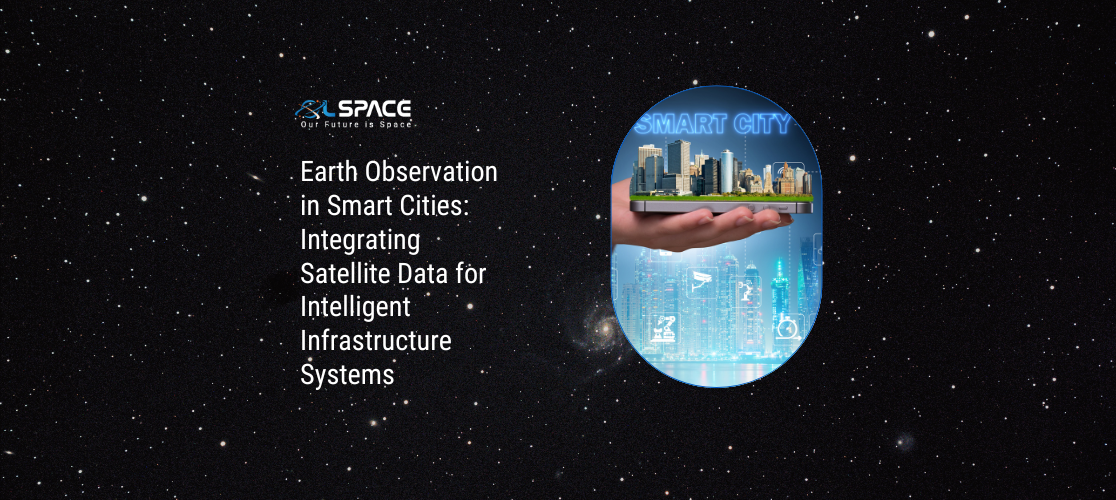07 July 2023
Earth Observation in Smart Cities: Integrating Satellite Data for Intelligent Infrastructure Systems

Smart cities are harnessing the power of technology and data to create more efficient, sustainable, and livable urban environments. Earth observation, utilising satellite data and remote sensing technologies, plays a crucial role in the development and management of intelligent infrastructure systems in smart cities. By integrating satellite data, smart cities can gain valuable insights into various aspects of urban life, including transportation, energy management, environmental monitoring, and urban planning. This blog post explores the significance of earth observation in smart cities and how satellite data is used to create intelligent infrastructure systems.
Real-time Monitoring and Management: Earth observation provides real-time monitoring and management capabilities for smart cities. Satellites equipped with sensors can collect data on various urban parameters, such as air quality, traffic patterns, energy consumption, and water resources. This data enables smart city managers to make informed decisions and take proactive actions to optimise infrastructure systems. For example, real-time monitoring of traffic flow can help optimise transportation routes, reduce congestion, and improve overall mobility within the city.
Urban Planning and Development: Satellite data supports urban planning and development in smart cities. By analysing satellite imagery, urban planners can gain insights into land use, population density, and infrastructure development. This information aids in making informed decisions regarding the location of new infrastructure projects, optimising land use, and ensuring the efficient allocation of resources. Satellite data also helps in identifying areas prone to natural hasards, allowing for better risk assessment and informed urban planning practices.
Environmental Monitoring and Sustainability: Earth observation is instrumental in monitoring the environment and promoting sustainability in smart cities. Satellite data can be used to track changes in vegetation cover, identify pollution sources, monitor water resources, and assess the impact of urban development on the ecosystem. This information enables smart cities to implement targeted environmental management strategies, such as urban greening initiatives, air quality improvement programs, and efficient water resource management. By integrating satellite data into sustainability efforts, smart cities can reduce their environmental footprint and enhance the quality of life for residents.
Infrastructure Asset Management: Satellite data supports efficient management of infrastructure assets in smart cities. By utilizing remote sensing technologies, smart city managers can monitor the condition of infrastructure systems, such as roads, bridges, and buildings. This data helps in identifying maintenance needs, predicting potential failures, and optimising resource allocation for infrastructure upkeep. By proactively managing infrastructure assets based on satellite data, smart cities can enhance their resilience, prolong asset lifespan, and minimise disruption to essential services.
Emergency Response and Disaster Management: In times of emergencies and natural disasters, satellite data becomes invaluable for smart cities. Earth observation enables real-time monitoring of disaster-affected areas, aiding in emergency response and recovery efforts. Satellite imagery can help assess damage, identify areas in need of assistance, and support search and rescue operations. By integrating satellite data into their disaster management systems, smart cities can enhance their preparedness, response, and recovery capabilities, ensuring the safety and well-being of their residents.
Data Integration and Analytics: Integrating satellite data with other sources of urban data, such as IoT sensors and social media feeds, enables comprehensive data analytics for smart cities. By combining different data streams, smart cities can gain a holistic view of urban dynamics, make data-driven decisions, and uncover hidden patterns and correlations. This integrated data approach enhances the efficiency and effectiveness of intelligent infrastructure systems, enabling proactive interventions, resource optimisation, and improved urban services.
Conclusion: Earth observation plays a vital role in the development and management of intelligent infrastructure systems in smart cities. By integrating satellite data, smart cities can gain real-time monitoring and management capabilities, support urban planning and development, monitor the environment, optimise infrastructure asset management, improve emergency response, and leverage comprehensive data analytics. Satellite data empowers smart cities to create more efficient, sustainable, and livable urban environments, enhancing the quality of life for residents and driving the transformation towards smarter and more resilient cities.
